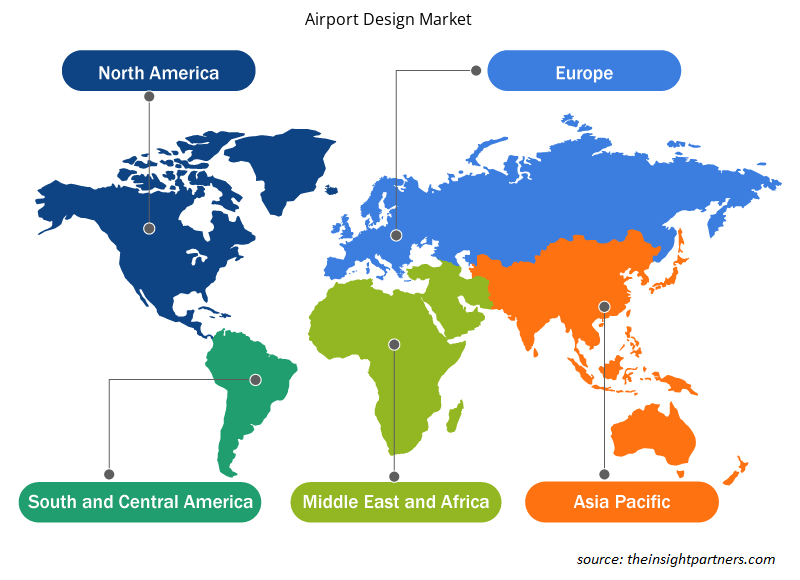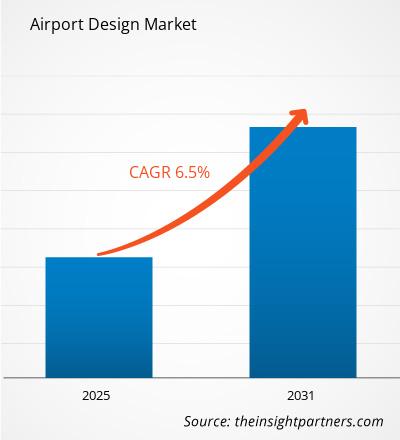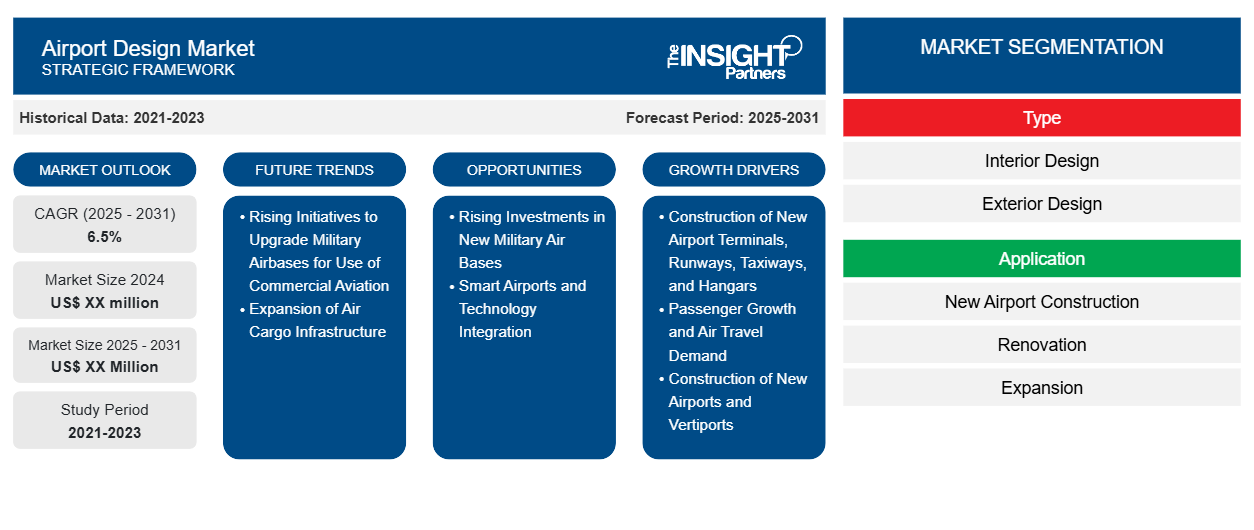Es wird erwartet, dass der Markt für Flughafendesign von 2023 bis 2031 eine durchschnittliche jährliche Wachstumsrate (CAGR) von 6,5 % verzeichnet und dass die Marktgröße von XX Millionen US-Dollar im Jahr 2023 auf XX Millionen US-Dollar im Jahr 2031 wächst.
Der Bericht ist segmentiert nach Typ (Innenarchitektur, Außenarchitektur); Anwendung (Neubau von Flughäfen, Renovierung, Erweiterung). Die globale Analyse ist weiter auf regionaler Ebene und nach wichtigen Ländern aufgeschlüsselt. Der Bericht bietet den Wert in USD für die oben genannte Analyse und die Segmente.
Zweck des Berichts
Der Bericht „Airport Design Market“ von The Insight Partners soll die aktuelle Landschaft und das zukünftige Wachstum sowie die wichtigsten treibenden Faktoren, Herausforderungen und Chancen beschreiben. Dies wird verschiedenen Geschäftspartnern Einblicke geben, wie zum Beispiel:
- Technologieanbieter/-hersteller: Um die sich entwickelnde Marktdynamik zu verstehen und die potenziellen Wachstumschancen zu kennen, damit sie fundierte strategische Entscheidungen treffen können.
- Investoren: Durchführung einer umfassenden Trendanalyse hinsichtlich der Marktwachstumsrate, der finanziellen Marktprognosen und der Chancen entlang der Wertschöpfungskette.
- Regulierungsbehörden: Zur Regulierung von Richtlinien und Überwachungsaktivitäten auf dem Markt mit dem Ziel, Missbrauch zu minimieren, das Vertrauen der Anleger zu bewahren und die Integrität und Stabilität des Marktes aufrechtzuerhalten.
Flughafendesign Marktsegmentierung
Typ
- Innenarchitektur
- Außendesign
Anwendung
- Neubau eines Flughafens
- Renovierung
- Erweiterung
Passen Sie diesen Bericht Ihren Anforderungen an
Sie erhalten kostenlose Anpassungen an jedem Bericht, einschließlich Teilen dieses Berichts oder einer Analyse auf Länderebene, eines Excel-Datenpakets sowie tolle Angebote und Rabatte für Start-ups und Universitäten.
-
Holen Sie sich die wichtigsten Markttrends aus diesem Bericht.Dieses KOSTENLOSE Beispiel umfasst eine Datenanalyse von Markttrends bis hin zu Schätzungen und Prognosen.
Wachstumstreiber auf dem Flughafendesignmarkt
- Bau neuer Flughafenterminals, Start- und Landebahnen, Rollbahnen und Hangars: Die wachsende globale Flotte kommerzieller Flugzeuge ist einer der Hauptfaktoren, die die Nachfrage nach neuen Flügen, Terminals, Start- und Landebahnen und Hangars an verschiedenen Flughäfen erzeugen, um dem wachsenden Passagierverkehr weltweit gerecht zu werden. Dies steigert auch die Investitionen der Flughafenbehörden in die Modernisierung ihrer jeweiligen Flughafenanlagen, um eine größere Anzahl von Flugzeugen aufnehmen zu können, was auch die Betriebseffizienz des gesamten Flughafens verbessert. Dies wird auch durch die Einführung von Billigfluggesellschaften unterstützt, die den Fluggastverkehr weltweit unterstützt haben. Im März 2023 gab der kanadische Stadtrat von Kelowna die Genehmigung einer Finanzierung von 90 Millionen US-Dollar für das Erweiterungsprojekt des Kelowna Airport-Terminals bekannt. Somit trägt der Bau neuer Flughafenterminals, Start- und Landebahnen, Rollbahnen und Hangars zum Wachstum des Flughafendesignmarktes weltweit bei.
- Passagierwachstum und Nachfrage nach Flugreisen: Da sich der globale Flugverkehr aufgrund der wachsenden Mittelschicht, des Tourismus und des internationalen Geschäfts weiter erholt und ausweitet, besteht ein zunehmender Bedarf an der Modernisierung und Erweiterung von Flughäfen. Diese wachsende Nachfrage nach Passagierkapazität und effizienterem Betrieb ist ein wichtiger Treiber für Investitionen in neue Flughafendesigns und Infrastrukturverbesserungen. Bau neuer Flughäfen und Vertiports: Vertiports sind Zentren für Fahrzeuge mit vertikalem Start und Landung wie eVTOL-Fahrzeuge, Drohnen und Lufttaxis. Die steigende Nachfrage nach kompetentem Stadtverkehr und Entwicklungen in der eVTOL-Technologie sowie der Mangel an verfügbarem Land zum Bau konventioneller Vertiports treiben den Bedarf an fortschrittlichen Vertiports voran. Im Jahr 2022 kündigte VPorts an, ein Netzwerk von Vertiports in Quebec aufzubauen und Korridore zwischen Quebec und den USA speziell für eVTOL-Flugzeuge zu bilden. Im Jahr 2023 arbeitete Ferrovial Airports mit Eve Air Mobility zusammen, um Vertiports für eVTOL-Flugzeuge zu entwickeln. Die wachsende Nachfrage nach nachhaltigen und emissionsarmen Ansätzen in der Luftfahrt- und Logistikbranche steigert die Nachfrage nach neuen Flughäfen für eVTOL-Flugzeuge. Die Weiterentwicklung von Vertiports kann städtische Strategien für effiziente und umweltfreundliche Stadttransport- oder Logistikmodi verändern. Daher wird erwartet, dass der zunehmende Bau neuer Vertiports in den kommenden Jahren neue Möglichkeiten für das Wachstum des Flughafendesignmarktes schaffen wird.
Zukünftige Trends auf dem Flughafendesignmarkt
- Zunehmende Initiativen zur Aufrüstung von Militärflughäfen für die kommerzielle Luftfahrt: Die Regierungen mehrerer Länder haben Initiativen ergriffen, um ihre jeweiligen Militärflughäfen für die Landung und den Betrieb kommerzieller Flugzeuge zuzulassen, um die Bewältigung des steigenden Passagieraufkommens in verschiedenen Regionen zu erleichtern, bis neue kommerzielle Flughäfen in Betrieb sind. Einige andere Initiativen umfassen die Aufrüstung ausgewählter Militärflughäfen zu Hybridflughäfen. Beispielsweise erlauben mehrere Militärflughäfen in den USA wie AF Plant 42, Palmdale, CA; Barter Island LRRS, Barter Island; AK Charleston AFB, Charleston, SC; Dover AFB, Dover, DE; Eglin AFB, Valparaiso, FL; Grissom AFB, Peru, IN; und Kelly/Lackland AFB, TX die gemeinsame Nutzung dieser bestehenden Militärflughäfen, wenn ein ziviler Sponsor den Militärflughafen für seine Lande- oder Startoperationen nutzen möchte. Daher wird erwartet, dass zunehmende Initiativen zur Aufrüstung von Militärflughäfen für die kommerzielle Luftfahrt das Wachstum des Flughafendesignmarktes im Prognosezeitraum ankurbeln werden.
- Ausbau der Luftfrachtinfrastruktur: Mit dem Aufstieg des E-Commerce und des globalen Handels steigt die Nachfrage nach modernen Luftfrachtanlagen. Dies bietet dem Flughafendesignmarkt die Möglichkeit, eine spezielle Infrastruktur zu schaffen, die dem wachsenden Luftfrachtvolumen gerecht wird und effiziente Logistiksysteme, spezielle Frachtterminals und verbesserte Sicherheitsfunktionen umfasst.
Marktchancen für Flughafendesign
- Steigende Investitionen in neue Militärflughäfen: Das sich entwickelnde Szenario der modernen Kriegsführung hat die Regierungen verschiedener Länder auf der ganzen Welt gezwungen, erhebliche Mittel und Finanzhilfen für die jeweiligen Verteidigungs- und Streitkräfte bereitzustellen. Die Mittelzuweisung im Verteidigungshaushalt unterstützt Armee und Streitkräfte beim Kauf verbesserter Technologien und Ausrüstung von inländischen oder internationalen Entwicklern. Auf der anderen Seite nehmen aufgrund der wachsenden Mittelzuweisung im Verteidigungshaushalt die Modernisierungen von Militär- und Armeefahrzeugen zu. Darüber hinaus zeigen die steigenden Staatsausgaben, dass die Regierung ihren Fokus auf die Stärkung der nationalen Sicherheitskräfte legt. Zu diesem Zweck ergreifen die Regierungen verschiedener Länder mehrere Initiativen, um eine große Anzahl von Militärstützpunkten für Boden-, Luft- und Marineoperationen einzusetzen. So kündigte die indische Regierung im Oktober 2022 den Bau eines neuen Militärflughafens im Bundesstaat Gujarat im Westen Indiens an, der die seit langem bestehende strategische Lücke von 355 km zwischen den Luftwaffenstützpunkten Bhuj und Uttarlai verringern soll. Die steigenden Investitionen in die Entwicklung neuer Militärstützpunkte treiben also den Markt für Flughafendesign an.
- Intelligente Flughäfen und Technologieintegration: Der Trend zu „intelligenten“ Flughäfen beschleunigt sich durch die Integration fortschrittlicher Technologien wie biometrische Identifikation, KI-gestützte Sicherheitssysteme, IoT für Echtzeitüberwachung und automatisierte Check-in-Prozesse. Diese Innovationen steigern die Betriebseffizienz, verbessern das Passagiererlebnis und erhöhen die Sicherheit.
Regionale Einblicke in den Markt für Flughafendesign
Die regionalen Trends und Faktoren, die den Flughafendesignmarkt während des Prognosezeitraums beeinflussen, wurden von den Analysten von Insight Partners ausführlich erläutert. In diesem Abschnitt werden auch die Marktsegmente und die Geografie des Flughafendesignmarkts in Nordamerika, Europa, im asiatisch-pazifischen Raum, im Nahen Osten und Afrika sowie in Süd- und Mittelamerika erörtert.

- Erhalten Sie regionalspezifische Daten zum Flughafendesignmarkt
Umfang des Marktberichts zum Flughafendesign
| Berichtsattribut | Details |
|---|---|
| Marktgröße im Jahr 2023 | XX Millionen US-Dollar |
| Marktgröße bis 2031 | XX Millionen US-Dollar |
| Globale CAGR (2023 - 2031) | 6,5 % |
| Historische Daten | 2021-2022 |
| Prognosezeitraum | 2024–2031 |
| Abgedeckte Segmente |
Nach Typ
|
| Abgedeckte Regionen und Länder |
Nordamerika
|
| Marktführer und wichtige Unternehmensprofile |
|
Dichte der Marktteilnehmer im Flughafendesign: Die Auswirkungen auf die Geschäftsdynamik verstehen
Der Markt für Flughafendesign wächst rasant, angetrieben durch die steigende Nachfrage der Endnutzer aufgrund von Faktoren wie sich entwickelnden Verbraucherpräferenzen, technologischen Fortschritten und einem größeren Bewusstsein für die Vorteile des Produkts. Mit steigender Nachfrage erweitern Unternehmen ihr Angebot, entwickeln Innovationen, um die Bedürfnisse der Verbraucher zu erfüllen, und nutzen neue Trends, was das Marktwachstum weiter ankurbelt.
Die Marktteilnehmerdichte bezieht sich auf die Verteilung der Firmen oder Unternehmen, die in einem bestimmten Markt oder einer bestimmten Branche tätig sind. Sie gibt an, wie viele Wettbewerber (Marktteilnehmer) in einem bestimmten Marktraum im Verhältnis zu seiner Größe oder seinem gesamten Marktwert präsent sind.
Die wichtigsten auf dem Markt für Flughafendesign tätigen Unternehmen sind:
- Arup
- AVIC CAPDI
- Hirschen
- Goldene Gottesanbeterin
- HOK
Haftungsausschluss : Die oben aufgeführten Unternehmen sind nicht in einer bestimmten Reihenfolge aufgeführt.

- Überblick über die wichtigsten Akteure auf dem Flughafendesignmarkt
Wichtige Verkaufsargumente
- Umfassende Abdeckung: Der Bericht deckt die Analyse von Produkten, Diensten, Typen und Endbenutzern des Flughafendesign-Marktes umfassend ab und bietet einen ganzheitlichen Überblick.
- Expertenanalyse: Der Bericht basiert auf dem umfassenden Verständnis von Branchenexperten und Analysten.
- Aktuelle Informationen: Der Bericht stellt durch die Abdeckung aktueller Informationen und Datentrends Geschäftsrelevanz sicher.
- Anpassungsoptionen: Dieser Bericht kann angepasst werden, um spezifische Kundenanforderungen zu erfüllen und die Geschäftsstrategien optimal anzupassen.
Der Forschungsbericht zum Flughafendesignmarkt kann daher dabei helfen, die Branchensituation und Wachstumsaussichten zu entschlüsseln und zu verstehen. Obwohl es einige berechtigte Bedenken geben kann, überwiegen die allgemeinen Vorteile dieses Berichts tendenziell die Nachteile.
- Historische Analyse (2 Jahre), Basisjahr, Prognose (7 Jahre) mit CAGR
- PEST- und SWOT-Analyse
- Marktgröße Wert/Volumen – Global, Regional, Land
- Branchen- und Wettbewerbslandschaft
- Excel-Datensatz
Aktuelle Berichte
Erfahrungsberichte
Grund zum Kauf
- Fundierte Entscheidungsfindung
- Marktdynamik verstehen
- Wettbewerbsanalyse
- Kundeneinblicke
- Marktprognosen
- Risikominimierung
- Strategische Planung
- Investitionsbegründung
- Identifizierung neuer Märkte
- Verbesserung von Marketingstrategien
- Steigerung der Betriebseffizienz
- Anpassung an regulatorische Trends























 Kostenlose Probe anfordern für - Flughafendesignmarkt
Kostenlose Probe anfordern für - Flughafendesignmarkt